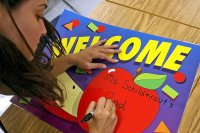Kicking Off the School Year With Intention
Setting aside time for relationship building at the start of school can pay big dividends throughout the year.
In my 12 years of teaching, I have come to realize that how I start the year is a sign of the way the year will conclude. A strong start to the year makes everything else easier, while a weak start to the year is nearly impossible to remedy. There are some foundational approaches that have served me—and my students—well.
The First Impression
Research indicates that people need just seconds to form ideas about someone they are just meeting. How can we as teachers maximize the first impression?
As child psychologist Haim Ginott noted, the teacher is “the deciding element” of the climate in the classroom. Here are some things you can do to be meaningfully present the first day of school: Welcome students at the door with a warm greeting. Make it clear where they need to sit. Be intentional with your body placement and posture, eye movements, and vocal approach, because students are reading you, consciously and unconsciously, and responding to what psychologists call “emotional contagion.”
Though teachers don’t need to be experts in feng shui, I have found it helpful to be mindful of the physical space my students are entering on the first day. This includes having a tidy room prepared with resources, a thoughtful desk arrangement with smart traffic flow, and objectives and agendas posted in spaces clearly marked for specific classes. I also like personal touches that generate conversation, such as photos or posters that are important to me or a diffuser with essential oils.
Have a balance of posted content and free wall space for future student contributions. Make sure that everything has a place. Disheveled paperwork or inaccessible resources not only communicate a lack of organization but also hinder your work later in the year.
Building Relationships
Everything that happens during the first week or two of school is designed to build relationships. This starts with a proper introduction. I always start with a get-to-know-you survey asking questions such as the following:
- Who is a teacher that had a positive impact on you, and what did he or she do specifically?
- What are your pet peeves as a learner?
- Are there any conflicts (with people or arrangement) in this room I need to be aware of?
As students are completing this survey, I make a point to walk around the room, introduce myself with a firm handshake and eye contact, request the name each student wants to be called, and make sure I can correctly pronounce the name.
Icebreakers are another useful tool for initial relationship building. I ask students to find and share a particular item such as a children’s book, quote, song, poem, cartoon, or object that tells something important about who they are. Another option is to ask students to write and share a six-word memoir.
Circles are another way to share the work students have written, build connections, establish norms, and identify and address individual or community needs. For example, this year I started with a norming circle where I asked two guiding questions: What do you need from this community to be successful and safe? And what will you offer to this community to create that successful and safe environment? Students’ responses then became the classroom rules.
An important element of relationship building is modeling authentic reflection. I read the surveys they completed and compile lists of their needs and pet peeves. Then I publicly share a bit about how I will utilize my strengths and improve my weaknesses to honor student preferences. I also share survey data from last year’s students to let them know what I do well and what I’ll be working on this year.
Establishing Clarity
Before any student ever shares, establish nonnegotiable parameters for respectful attention. I make sure to explicitly explain what active listening looks and sounds like, why confidentiality is important, how side conversations make students feel insecure, and how scary it is to share a part of ourselves. Then I revisit these concepts frequently. This not only creates a strong community but also lays the groundwork for the risks that rigorous learning will later require.
Share the syllabus only after connections are built; this delay demonstrates that relationships are most important and that clarity matters in this class. Through previewing the syllabus, students are exposed to the regulations required by school, the content and objectives, and an overview of what they can expect from my discipline and pedagogical style.
It may seem odd that there is no direct content instruction the first few days, but the major goal is to build a solid foundation. Intentional investment in relationships and expectations at the outset creates an environment ripe for deeper learning and fewer management issues throughout the year.
